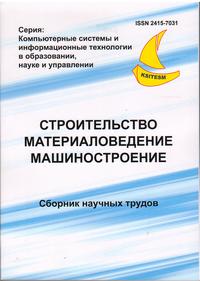Simulation piping in various graphical environments.
Keywords:
BIM- technology, modeling, education, graphical environment.Abstract
Abstract: The goal - improving engineering training students, through improved training techniques used today in high school, as a result of the widespread introduction in the educational process of electronic charting software. As a result, the development of which students will be able to perform all graphics tasks, applicable to the requirements of information modeling. The technique -The newest information technologies in teaching allow greater use of scientific and educational potential of leading universities and institutions to attract teachers to create distance learning courses, to expand the audience of students for active use of in novative features, such as graphics packages. Results - the development of construction of engineering networks skills students. Scientific novelty - the introduction into the educational process of innovative technologies for modeling various utilities, such as heating. The practical importance - Information technology - a combination of methods, processes, and software and hardware, integrated into the process chain, ensuring the collection, processing, storage, transmission and display of information, enabling a systematic way to organize the optimal interaction between the teacher and the student in order to achieve results training. To convert the course o n computer technology of training the teacher must have an understanding not only of the subject area, have the skills to syste matize the knowledge to competently use of teaching methods, to be well informed about the possibilities of information technology, as well as to know what computer support is achieved by means of one or the other reception. In addition, he must be informed of the technical and software that will be available to him when accompanied by a learning process, so that future engineers could u se in their work process all the benefits of BIM. Materials introduced into the educational process of the department "Descrip tive Geometry and Graphics". Designed for students specialty "Building and civil engineering" specialty "Heat and ventilation" day and in absentia - remote forms of training.
References
Anufriev D. P., Petrov I. Y. and Shikulskaya O. M. Vnedrenie instrumentov BIM v obrazovatelnyy protsess stroitelnogo vuza [Implementation of BIM tools in the educational process of the construction of the university] / Astrakhanskiy inzhenerno-stroitelnyy institut [ Astrakhan Institute of Civil Engineering] . Available at: http://www.aucu.ru/journal/files/documents/44-redaktor/prsk_2015/prsk_2015_54-62.pdf. (in Russian).
Gorbunova L.I. and Subbotina E. A. Ispolzovanie informatsionnykh tekhnologiy v protsesse obucheniya [The use of information technology in the learning process] / - Moscow: Molodoj uchenyy [Young scientist] no.4, 2013, pp. 544-547 Available at: http://moluch.ru/archive/51/6685/ Caps. screen - Checked: 20/08/2016. (in Russian).
Parkhomenko E.I. Primenenie sovremennykh informatsionnykh technologiy v obuchenii studentov tekhnicheskikh distsiplin [Use of modern information technologies in teaching students of technical subjects]. Problemy i perspektivy razvitiya obrazovaniya: materialy II mezhdunar. nauch. konf.[Problems and prospects of development of education: Materials II Intern. scientific. Conf.]. Perm: Mercury Publ., 2012, pp. 151-153 p. (in Russian).
Plan vnedreniya tekhnologiy BIM. Put stroitelnoy otrasli k innovatsiyam [Plan BIM technology adoption. The path of the construction industry to innovate] // URL: Available at: http://www.mosecostroy.ru/novosti/?ID=1585 Caps. screen - Checked: 05/08/2016. (in Russian).
Tovazhnyanskiy L. L., Romanovskiy O. G., Bondarenko V. V., Ponomarev O. S. and Chervaneva Z. O. Osnovy pedagogiki vysshey shkoly [Fundamentals of the Higher School of Pedagogy]. Kharkov: NTU "KhPI", 2005. - 600 p. (in Russian).
Heifets A. L. and Vasilyeva V. N. Kompyuternoe 3 D – modelirovanie uzlov v kurse inzhenernoy grafiki [Computer 3D -modeling nodes in an engineering drawing course]. Materialy mezhdunarod. nauch.metod. konf. [Materials Intern. scientific. -Method. Conf.]. PGUSA Publ., 2009, pp. 9-10 . (in Russian).
Yampolskiy A. Revolyutsii v proektirovanii [Revolution in design] / Available at: https://dwg.ru/pub/38. (in Russian).
Downloads
Published
Issue
Section
License
Редакція Видання категорично засуджує прояви плагіату в статтях та вживає всіх можливих заходів для його недопущення. Плагіат розглядається як форма порушення авторських прав і наукової етики.
При виявлені у статті більш ніж 25% запозиченого тексту без відповідних посилань та використання лапок, стаття кваліфікується як така, що містить плагіат. У цьому випадку стаття більше не розглядається редакцією, а автор отримує перше попередження.
Автори, в статтях яких повторно виявлено плагіат, не зможуть публікуватися в усіх журналах Видавництва ДВНЗ «Придніпровська державна академія будівництва та архітектури».
Автори, які публікуються у цьому журналі, погоджуються з наступними умовами:
- Автори залишають за собою право на авторство своєї роботи та передають журналу право першої публікації цієї роботи на умовах ліцензії Creative Commons Attribution License, котра дозволяє іншим особам вільно розповсюджувати опубліковану роботу з обов'язковим посиланням на авторів оригінальної роботи та першу публікацію роботи у цьому журналі.
- Автори мають право укладати самостійні додаткові угоди щодо неексклюзивного розповсюдження роботи у тому вигляді, в якому вона була опублікована цим журналом (наприклад, розміщувати роботу в електронному сховищі установи або публікувати у складі монографії), за умови збереження посилання на першу публікацію роботи у цьому журналі.
- Політика журналу дозволяє і заохочує розміщення авторами в мережі Інтернет (наприклад, у сховищах установ або на особистих веб-сайтах) рукопису роботи, як до подання цього рукопису до редакції, так і під час його редакційного опрацювання, оскільки це сприяє виникненню продуктивної наукової дискусії та позитивно позначається на оперативності та динаміці цитування опублікованої роботи (див. The Effect of Open Access).

